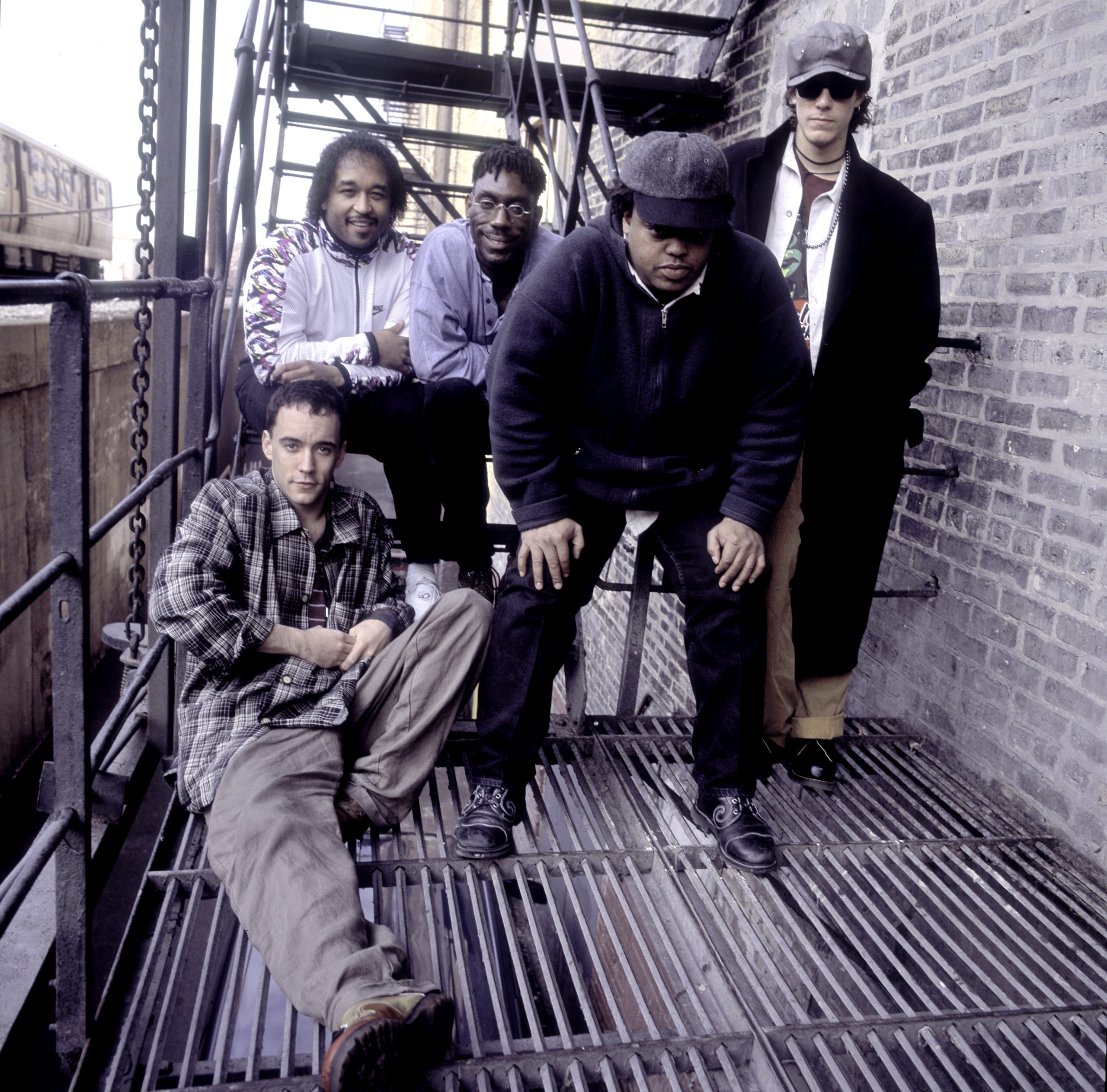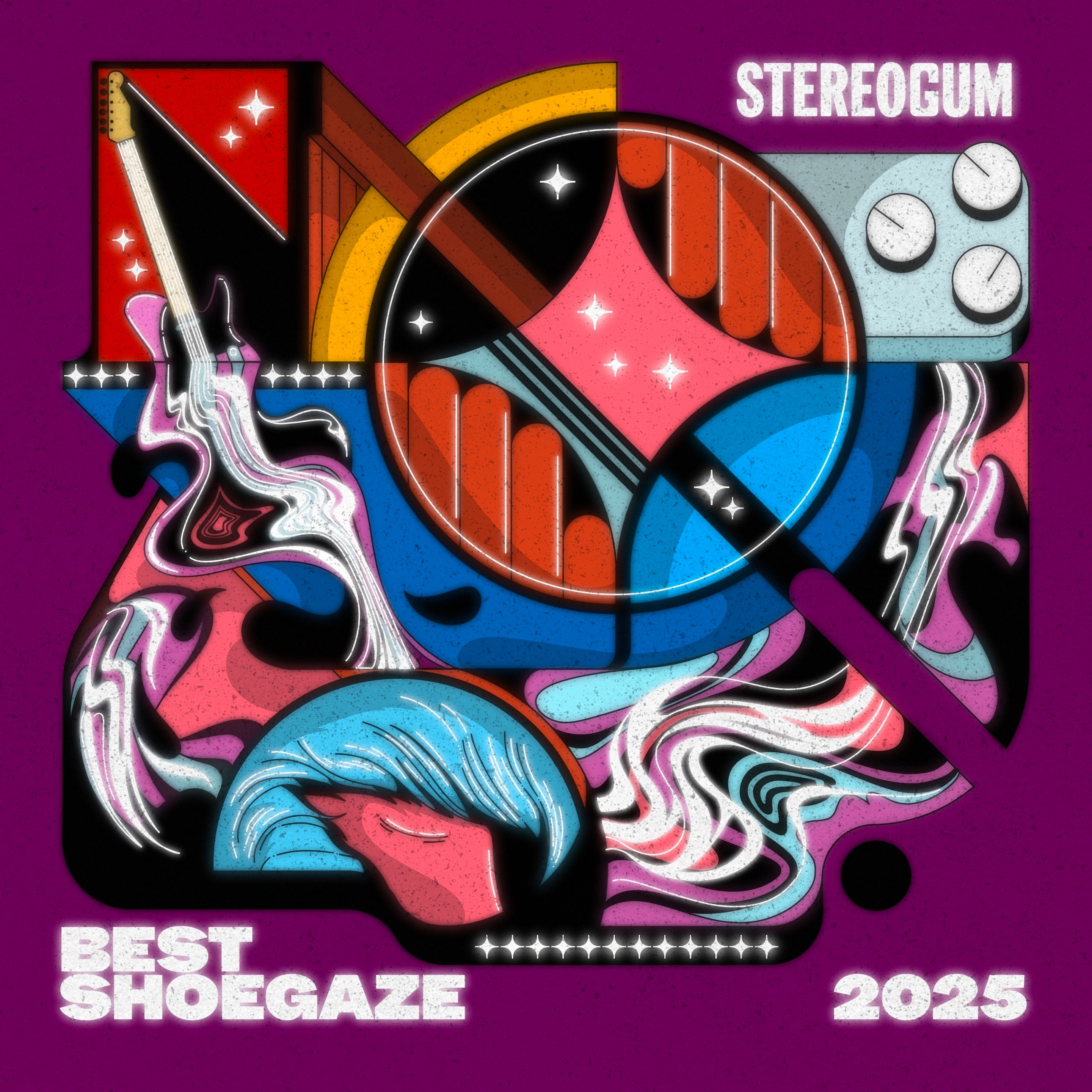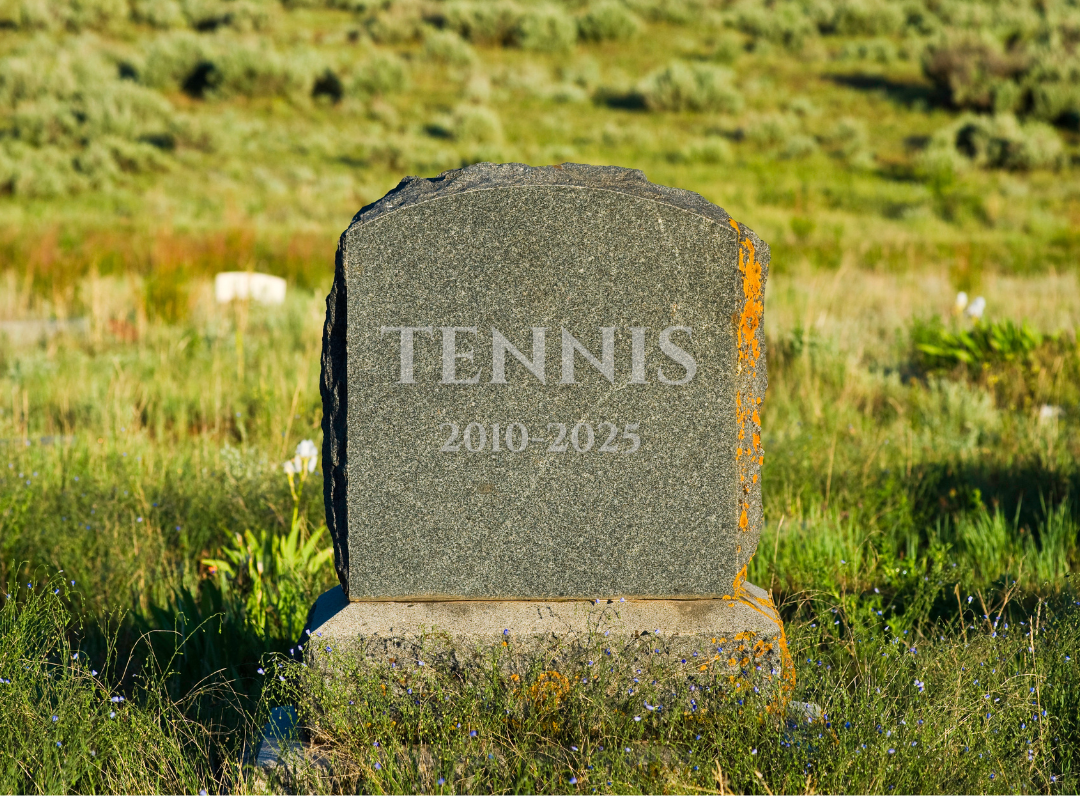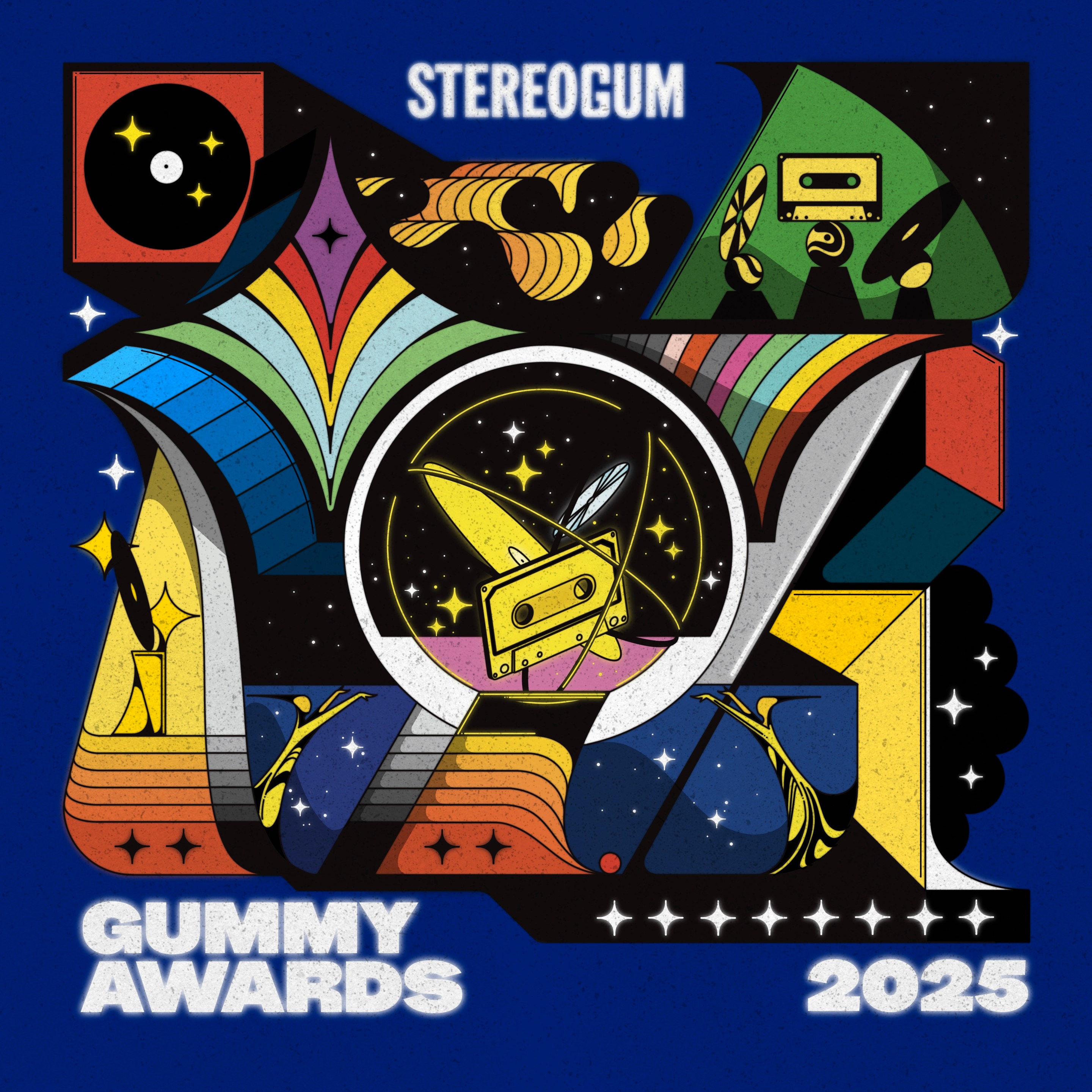Twenty-five years in, it's still hard to know how to talk about the Dave Matthews Band. Since the 1993 arrival of Remember Two Things, their independently released debut preceding the blockbuster Under The Table And Dreaming in 1994, Matthews and the band that bears his name have been building up one of those classic, strange paradoxes in music history. They are wildly popular, but with the staying power that comes with accruing countless true diehards in their fanbase; in some ways, they are an institution.
And yet along the way they have been perceived as one of the least cool, most critically maligned (or at least dismissed) artists of their generation. It was only recently that you could start to see the tide potentially beginning to turn, that you could start to see ... people defending Dave Matthews Band.
Working with songs written by Matthews, the original core band came together in the early '90s -- drummer Carter Beauford, saxophonist LeRoi Moore, then-teenaged bassist Stefan Lessard, and violinist Boyd Tinsley. (The band has grown and shifted over the years; Moore tragically died in 2008, and Tinsley recently departed before sexual assault allegations against him were made public last month.) All dexterous players, they formed a unique, specific sound, acoustic rock with jazz inflections and improvisations that could incorporate funk or veer into full-on pop balladry.
This is part of what makes their story strange: Along the way, you might've been able to group DMB in with various mini-moments in recent pop history, but they don't really feel of an exact piece with any of them exactly. At first, maybe their sweet and sometimes-goofy acoustic rock placed them alongside other '90s hitmakers like Counting Crows and Hootie & The Blowfish relative to the down-tuned, flannel-clad distortion that had become the more critically approved zeitgeist at the dawn of the '90s.
Later on, as those peers faded and DMB's pop clout grew, songs like “The Space Between” and “Where Are You Going” seemed to fit in with but also lay the groundwork for turn-of-this-century singer-songwriter pop. (Early John Mayer, for example, sounds a whole lot like Matthews in his poppier mode, just with the edges sanded off.) Then of course, there was the most odious characterization, the one that kept them off to the side and reviled the same it garnered them so many devotees: jam band.
This, it would seem, is the primary descriptor keeping DMB down. If you look at the '90s and see grunge and scraggly indie and electronica and the arc of rap from insurgent artistic force to burgeoning mainstream monolith, there are certain strains that just don't register as being as important, as big. But the jam band scene really formulated then, with bands like Phish taking up the mantle of the Dead -- constantly shape-shifting, epic shows that fostered a community of fans that would follow groups on the road and trade tapes of gigs, a community that became a thing unto itself regardless of what the outside world cared about their chosen band. The funny thing is, I remember jam band listeners partially rejecting Dave because of his hits, but there's no question that DMB has also touched that culture, too, and when recent pop history is being solidified there's little more damning than being associated with this particular subculture.
The live show has always been a crucial part of experiencing DMB, and go to any gig and you will indeed find those jam band aficionados. (Which, in more extreme cases, means you will also find white people with dreadlocks. Comes with the territory.) But that's the thing: As the years went on, you'd also find a lot of clean-cut college bros. You'd also find a lot of moms with minivans, arriving with their friends and children. Without ever defining one specific era or moment, without ever having the chance to be a “voice of the generation” in vogue type, Dave Matthews gradually built up a universality separate from whatever the cultural currents were at that time. DMB is their own narrative, enduring beyond the things we may have at some point associated with them.
This is, however, not to suggest they were some cultish concern operating far to the side of the mainstream. They actually sell records, and they are a touring juggernaut. They had a string of pretty ubiquitous hits, the kinds of songs that crept into the culture, sometimes thanks to a romantic comedy sync and sometimes thanks to being the sort of middle-of-the-road pop cut that works in almost any chain restaurant setting.
But along the way they've also amassed a deep selection of fan favorites; they're one of those bands that will play a radically different set each night and always drop in things that gets some sect of the fanbase going crazy. What DMB doesn't get as much credit for is all the other stuff -- we know they can be funky, we know they can strike with a heartfelt singer-songwriter ballad. But there's also a darkness underlying a lot of DMB's music, and there are a lot of haunting deep cuts spread throughout their career.
On some level, none of that matters. We live in an era where everything that was once popular and uncool gets revived, revisited, re-evaluated. At one point Fleetwood Mac was coked-out '70s anathema to the indie set; within a decade every indie band overflowed with their love of Rumours. Music nerd picks like Steely Dan even come across as cool now. Remember when, some 10 or 15 years before the National collected all their big name indie friends for a sprawling five hour boxset tribute to the Grateful Dead, you would've been laughed out of the room for saying you listened to the OG jammers?
Still, some bands will never be cool. Some bands never get that critical turnaround, the acknowledgment that one era or another's hang-ups was what made us think they were lame in the first place. For most of the last two decades, it's seemed like Dave Matthews Band was going to be one of those artists. They'd remain beloved, but never quite get that respect.
Why, exactly? Well, even when mounting a defense of this band, there are caveats you have to include. For every surprisingly gritty track, there'll be some goofy scat or a ballad that lilts just a bit too much. For every surprisingly unnerving composition, there'll be the counter-attack of schmaltz and cheese. For every resounding and affecting lyric, there'll be something clunky around the corner. Sometimes listening to Dave Matthews songs can make you feel like they're just a few degrees askew, the kinds of things where you listen and think, “In other hands, this could've been a stone-cold classic.” He's got better albums than you remember, a lot of them just suffer from an anonymous studio-player type slickness.
Let's be honest here, though. All those qualifications above? You could say the same for careers far more praised than DMB's. You could say that for hallowed classic rock legends and you could say that for some of DMB's contemporaries who were ostensibly cooler. There is a lot of baggage cluttering DMB's career. If you manage to brush it aside, you won't find something perfect, but you'll find something that has more than its share of worthwhile moments, something that doesn't deserve the noxious reputation that's often hung over them through the years.
Today, Dave Matthews Band are releasing a new album called Come Tomorrow, their first in six years, the longest gap they've taken between albums. And maybe something happened during that particular passage of time, maybe we've run out of other artists to re-examine, but the tone surrounding this rollout is notably different than when they unveiled Away From The World in 2012.
There was, of course, Lady Bird. The super-beloved 2017 film famously used “Crash Into Me” not only as a sync situating the movie in its time and place, but also a plot point. Lady Bird, she wasn't the cool kid, she was the kid letting her emotions go to Dave Matthews Band. But that's bound up in what made that film connect so broadly -- more of us were Lady Bird than weren't. More of us were the kid who just liked the thing that spoke to us regardless of its cultural standing. That part of the movie, it elicited a refrain of “I was that person,” accompanied by questions of whether, now, finally, we might look at DMB's legacy differently. A host of thinkpieces followed.
That could've been an isolated event, and a conversation that played out and fizzled on music Twitter. But that doesn't seem to be the case. In the wake of that and with all this time removed from DMB's initial rise, Come Tomorrow is being greeted with a another flurry of pieces, now taking a look at this band, acknowledging their strengths, questioning what it was that made so many of us bury our fandom or dismiss them with a sneer. Come Tomorrow has prompted positive reviews, and offered an opportunity to give the band a real chance. Ahead of it, Matthews participated in one of Vulture's In Conversation interviews with David Marchese, a now prestigious franchise after Marchese's expansive and internet-breaking (and occasionally mind-melting) chats with Quincy Jones and Julian Casablancas.
For me, it's a particularly strange moment. Like every other music critic, I'd proceed with some degree of self-consciousness whenever I recalled the depth of my DMB obsession at a younger age -- even now, I frame it that way, like I need to offer an explanation or apology. His music was in the atmosphere when I was growing up; my hometown was one of the sites where you could always rely on a summer DMB show. I went to most of them. I lived with his music for a long time. But I, too, hadn't gone back in some time, hadn't given it that other chance.
So on the occasion of Come Tomorrow, I did go back. I found songs I used to like that didn't register for me anymore. I found hits, more of them than I realized, where I still remembered every instrumental turn. I found albums that were stronger front to back than I recalled. And in the end I compiled a little list, an attempt to make a case for DMB's music. It is not a comprehensive list, but more of a personal one. It doesn't go into live renditions, because that's a whole other story. Even if you've always kept DMB at arm's length, you'll recognize some of the songs below; maybe it's possible to hear them in a new light today. And otherwise, I tried to let some of the famous songs rest in favor of deep cuts that had always seemed special. Check it out below. Maybe Dave Matthews Band is different than you remember, too.
“Ants Marching” (from Under The Table And Dreaming, 1994)
To be honest, you probably know whether you think this one sucks or not already. It's one of DMB's early signature songs, and either you find it irritating or you find it to be a charming earworm. One thing is certain either way: From the start, the band had their sound figured out, the jaunt of "Ants Marching" perfectly blending those sax and violin parts in.
“Rhyme & Reason” (from Under The Table And Dreaming, 1994)
"Dave gets fucking dark, man. He knows pain," avowed DMB-head Ryley Walker said to me when I spoke to him about his new album Deafman Glance recently and the conversation veered off course into revisiting Matthews' career. He isn't wrong -- Matthews has experienced loss, has seen vicious racism firsthand in both South Africa and Virginia. His music grapples with the state of the world, and the sometimes fractured state of the person singing it. A chunk of this list leans on those DMB songs, a side of the band people may not always be as aware of.
Case in point: Under The Table And Dreaming has some well-known jams, and it has some restrained and meditative highlights like "Typical Situation," but it also has "Rhyme & Reason." If this wasn't acoustic and lacerated by violins, this would be a grunge song. Matthews can stir up a ragged growl when he wants, and he deploys it well here, going mad-eyed as he desperately sings "My head won't leave my head alone/ And I don't believe it will/ Until I'm dead and gone."
“Dancing Nancies” (from Under The Table And Dreaming, 1994)
In another universe, or with a couple different decisions, Under The Table And Dreaming may have lived on as an inarguable classic of the '90s. You can't argue with a lot of the songwriting, especially when some of the lauded grunge bands were plenty lunk-headed on occasion. A classic 20-something battle with questions of what other paths life could've taken, "Dancing Nancies" is one of Dave's more emotive early tracks. And it builds into a hell of an affecting refrain.
"Jimi Thing" (from Under The Table And Dreaming, 1994)
This, on one hand, is dicey territory. There's something very, very '90s acoustic jam-rock about "Jimi Thing," from its Hendrix nod to the fact that the verses sorta sound like Sublime. But this song transforms, bursting into one of the most transporting choruses Matthews ever wrote.
“Warehouse” (from Under The Table And Dreaming, 1994)
A lot of the old favorites from Under The Table became live warhorses as the years went on, including "Warehouse." One of the band's early epics, it's an example of how DMB can sometimes disorientingly, sometimes effortlessly shift moods within a song, as "Warehouse" mutates from an ethereal echo to a bouncy folk-pop resolution and back into stranger territory.
“Two Step” (from Crash, 1996)
Sometimes, DMB are capable of moments of true, otherworldly beauty. That's never been more evident than in the intro to "Two Step," one of those pieces of music that just inherently feels like rising drama, like turning the first page of a story and watching a world unfold in front of you. Like "Warehouse," it's a bit of a shape-shifter, swinging from those enigmatic sections to more standard singalong DMB moments. But for a band who have given us a whole lot of journey songs, few have been more gratifying or alluring than "Two Step."
https://youtube.com/watch?v=-ZfBIiz2sbA
“Crash Into Me” (from Crash, 1996)
Personally, I prefer the drunken roar-along of "Drive In Drive Out" from Crash, but I have to hand it to Greta Gerwig: Lady Bird did make me hear this song anew. A deftly-paced, rain-soaked ballad that has just a bit of that autumnal '90s pop-rock element to it. The lyrics are still ... not great, though.
“Too Much” (from Crash, 1996)
Admittedly, this might be one of those goofy DMB songs that shouldn't have made this list. One of the main drawbacks of Matthews' music is when he goes over-affected with his vocals; he starts to sound like Kermit The Frog cracking open a second bottle of whiskey. And when he goes all in on throwing his voice around in "Too Much," he comes across like a bug-eyed Looney Tune. But also ... this song is just too much fun. They can ride a groove mercilessly when they want to.
“The Last Stop” (from Before These Crowded Streets, 1998)
Before These Crowded Streets, in many ways DMB's darkest and strangest album, recently celebrated its 20th anniversary in April. And if you were trying to convert someone with an ingrained distaste for Matthews & co., this might be where to start. The album rarely sounds like the urban setting its name and cover evoke; rather, haunting tracks like "Halloween" and "The Stone" or the hallucinatory "The Dreaming Tree" feel as if they take place deep in the untamed wilderness of an unknown country.
"The Last Stop" might be the best of the bunch. The abrupt oscillations between Tinsley's sinister violin part and Béla Fleck's guest-spot banjo shouldn't work as well as they do, but the latter offers brief respites in what's otherwise one of DMB's most relentless, frayed compositions.
“Don't Drink The Water” (from Before These Crowded Streets, 1998)
Perhaps the best one-two punch in the whole DMB canon, "The Last Stop" leaves you breathless and then immediately drops you into the foreboding swamp groove of "Don't Drink The Water." The lead single for Before These Crowded Streets, there is a radio edit of "Don't Drink The Water." But it's a rare DMB song that sprawls out to seven minutes not because of jams but because it needs the slow-burn build of its mood for its eventual climax to hit all the harder. There are parts that are almost dreamy, but eventually the song's constant simmer erupts into a fiery conclusion, made more frantic for how Alanis Morissette's background vocals play off Matthews' unraveling.
“Crush” (from Before These Crowded Streets, 1998)
There are reprieves from the darker entries of Before These Crowded Streets, one of which is the sensuous jazz-pop groover "Crush." This is one where it does feel like Dave's in the city. Part pretty ballad, part sinew-y bass, the whole thing sounds like a fresh romance unfolding in a smoke-filled club of the type that doesn't exist anymore, or maybe only existed in movies. There are some very characteristic Matthews melodies that pop up, but otherwise this is one place where the band actually does sound cool.
"The Space Between" (from Everyday, 2001)
After Before These Crowded Streets, DMB took three years to craft a followup, their longest break at the time after cranking out their first three major albums in quick succession. When they returned in 2001, it was with the electric rock sheen of Everyday, one of the more divisive installments in their catalog.
When you heard a song like "The Space Between" in the early '00s, it really didn't feel that many degrees removed Coldplay's big hits. In another world, you could picture this particular DMB hit as a melancholic post-Britpop lost gem.
“Everyday” (from Everyday, 2001)
Tracks like "I Did It" may have split longtime fans, but Everyday did have at least one DMB instant-classic on it, in the form of its title track. Arriving at the moment where DMB abandoned some of their eccentricities for a more streamlined aesthetic, "Everyday" does bear a resemblance to, say, the adult-contemporary phase Sting was indulging at the time. But come on -- it's also gleefully, infectiously uplifting. Something I remember from 2001: the easy joy that came with hearing this song. Something I did not remember from 2001: The video starred hat-lover and future 30 Rock cast member Jonah Friedlander.
“Grey Street” (from Busted Stuff, 2002)
There's a bit of convolution to DMB's late '90s/early '00s. Part of the reason Everyday took three years to arrive is that the band had first attempted an album with Steve Lillywhite, but were forced to abandon the sessions. Later, The Lillywhite Sessions leaked and became a treasure of fan lore, and an example of early internet disruptions of the music world.
Later, the band re-recorded a lot of those songs for Busted Stuff, which arrived the year after Everyday. One of those songs, "Grey Street," remains a high point amidst DMB's ballads, a song that perfectly balanced the band's strengths and pop inclinations.
“Digging A Ditch” (from Busted Stuff, 2002)
Epic swells make a song like "Grey Street," but in contrast there was also something like "Digging A Ditch" -- a quiet, ruminative ballad with a chorus you can never quite shake.
https://youtube.com/watch?v=O7kEJJ4-_KY
“Bartender” (from Busted Stuff, 2002)
Groups like DMB eventually collect too many epics to fit into one show, too many songs that start as seven or nine minute sagas but can bloom into even more expansive journeys onstage. Of these, "Bartender" has been a fan favorite for years. On record, it also functions as the perfectly spectral closer for Busted Stuff.
“Gravedigger” (from Some Devil, 2003)
The first half of the '00s were a productive time for Matthews -- the duo of Everyday and Busted Stuff were succeeded by his solo outing Some Devil, which in turn was followed by Stand Up in 2005. Speaking of Dave going dark -- Some Devil had some of his weightiest, most mature songwriting. One of the highlights, rightfully beloved by fans, was "Gravedigger." Again, sometimes Matthews really only seemed a couple degrees removed from his hipper peers; you could imagine mid-era Pearl Jam writing a song like this. And the song's chorus features one of the more memorable lyrics Matthews has written: "Gravedigger/ When you dig my grave/ Could you make it shallow/ So that I can feel the rain."
"American Baby" (from Stand Up, 2005)
Fight me.
“Louisiana Bayou” (from Stand Up, 2005)
Stand Up was another slick pop-rock outing from DMB, one that feels very of its mid-'00s time. Maybe it's the whole being a child of the '90s bit, but this one just hit at a time where I personally have warm memories of its release. Some of its songs, like closer "Hunger For The Great Light" or the rollicking Southern romp "Hello Again," are still a lot of fun today. One that stands out is the fried funk of "Louisiana Bayou," a percussive earworm that still gets stuck in my head all the time.
“Squirm” (from Big Whiskey And The GrooGrux King, 2009)
There are some fun songs on Big Whiskey And The GrooGrux King despite the darkness that overshadowed it given Moore's recent death. Songs like "Shake Like A Monkey" and "Spaceman" were hook-y but also loose. The songs that stood out, however, were the twin, distorted exorcisms of "Squirm" and "Time Bomb."
"Squirm" is true to its title. It sounds like a creature writhing on the ground, fighting its way out of its own skin and poised to attack. Tonally, there aren't many DMB songs like it -- there's swagger and teeth-baring alike here. When the song does finally rupture into its chorus, it sounds something like DMB's inverted, blackened take on an '00s U2 chorus.
https://youtube.com/watch?v=JEReWa6V1zA
“Time Bomb” (from Big Whiskey And The GrooGrux King, 2009)
"Squirm" felt heavy, like a roiling storm cloud. But "Time Bomb" is something else -- and not just an idea of what 2009 Pearl Jam could've/should've sounded like. It begins in suggestive territory, airy organs and Matthews in almost a sing-speak mutter. But the song gradually picks up pace, until it unspools into its runaway conclusion. By then, "Time Bomb" sounds like Matthews is trying to outrun himself, screaming and railing against the noise that rises up around him. It's one of the most desperate and most striking moments in his catalog.
https://youtube.com/watch?v=3gg8EQXV0e0
"Idea Of You" (from Come Tomorrow, 2018)
"Idea Of You" has been kicking around for years. So it's partially just a joy to finally hear Matthews cement its existence on one of his albums. But it's also got a classic DMB pop chorus, and even if it's an old song it's nice to hear Matthews enter his 50s with some tricks up his sleeve.
Listen to the playlist on Spotify.






